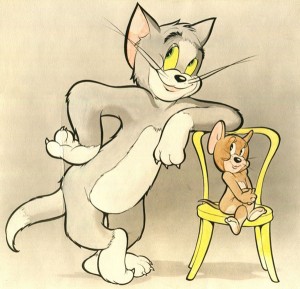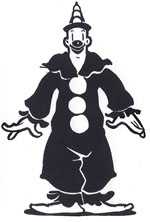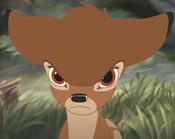
Joe Barbera (left) and Bill Hanna (right) in 1940
Joe Barbera and the Birth of Tom and Jerry. Animation legend Joe Barbera in an interview from the Dramalogue July 29-August 4 1993 issue. When I was working as a professional actor in Los Angeles, Dramalogue was pretty much the bible of actors to pick up every Thursday to see all the new listings for work. Surprisingly, this issue featured an interview with animation legend Joe Barbera by Tom Provenzano to tie in with Tom And Jerry: The Movie (1992).
 Barbera said, “The whole thing wasn’t working when I was first teamed with Bill (Hanna) at MGM. People seem to think it is just a breeze to take a purple spotted pig and a tall yellow giraffe and make them characters. It doesn’t work. So I leaned toward the most unoriginal idea in the world, a cat and a mouse. Very basic because I know wherever you went, no matter where you ran it – in Somalia or Beruit, you see a cat and a mouse and you know what’s going to happen. A chase. The question is how do you do it?
Barbera said, “The whole thing wasn’t working when I was first teamed with Bill (Hanna) at MGM. People seem to think it is just a breeze to take a purple spotted pig and a tall yellow giraffe and make them characters. It doesn’t work. So I leaned toward the most unoriginal idea in the world, a cat and a mouse. Very basic because I know wherever you went, no matter where you ran it – in Somalia or Beruit, you see a cat and a mouse and you know what’s going to happen. A chase. The question is how do you do it?
“They had been doing cat and mouse cartoons all over the place. There was Felix the Cat. Krazy Kat. A whole bunch of cats. Then Mighty Mouse. A whole bunch of mice. So when we started, we got back feedback about what a stupid, unoriginal idea. We were told it was just an old idea. How many can you possibly do? One or two? All this conversation about these two idiots trying to do a new series with an old idea.
“I would lay out the whole thing while I was writing the story. Then I’d turn it over to Bill who would concentrate on getting it out to the animators. We shot all these drawings I did and previewed them before we even started the cartoon. They got the best reaction.
“However, in their infinite wisdom, the head honcho from MGM said, ‘We don’t want to do any more cat and mouse cartoons. Don’t want to put all our eggs in one basket’. Fortunately a distributor in Texas demanded more of the ‘cat and the mouse’ cartoons. The first film we did using the name of Tom and Jerry won an Oscar, the first of seven.
“Oh, we also got complaints at MGM about how unoriginal the name was. Tom and Jerry is a popular Christmas drink.”
 Out of the Inkwell Review. “This little inkwell clown has attracted favorable attention because of a number of distinguishing characteristics. His motions, for one thing, are smooth and graceful. He walks, dances and leaps as a human being, as a particularly easy-limbed human being might. No dummy substitutes for the clown when he takes his hazardous journeys.” New York Times newspaper on February 22, 1920 commenting on Max Fleischer’s KoKo the clown who had premiered in 1919. Dave Fleischer was working as a clown at Coney Island and served as the rotoscoped model for the character.
Out of the Inkwell Review. “This little inkwell clown has attracted favorable attention because of a number of distinguishing characteristics. His motions, for one thing, are smooth and graceful. He walks, dances and leaps as a human being, as a particularly easy-limbed human being might. No dummy substitutes for the clown when he takes his hazardous journeys.” New York Times newspaper on February 22, 1920 commenting on Max Fleischer’s KoKo the clown who had premiered in 1919. Dave Fleischer was working as a clown at Coney Island and served as the rotoscoped model for the character.
The Ronin. Richard (Cheech) Marin of the comedy team Cheech and Chong in 1982 partnered with Tokyo Movie Shinsha to make an animated feature The Ronin based on the novel of the same name by William Dale Jennings who was also on board to do the script for the film. The film was budgeted at $5,500,000. Half the film would be produced at TMS studios in Tokyo and the other half at facilities that would be set up in Hollywood.
The story was about a boy in medieval Japan who searches to find the person who raped his mother and killed his father. When he finds the man, the boy discovers the criminal has become a saint in the eyes of the world. The producers said the predominant themes of sex and violence would be “ameliorated” to broaden its audience appeal.
“It is our desire to make a film which will reshape the animation medium and reflect the decades of the 80s as Yellow Submarine reflected the decades of the 1960s and as Ralph Bakshi’s work reflected the decade of the 1970s,” stated Marin.
 Anti-War Bambi. Some people in 1942 saw Disney’s animated feature Bambi as an anti-war parable and Walt did nothing to discourage that interpretation. In fact, the adaptation of the film that appears in Good Housekeeping magazine November 1942 has old Friend Owl saying, “But one of these days perhaps folks’ll get to understandin’ each other better and that’ll bring peace and contentment for everybody everywhere…” Bambi is renowned for only having about 950 words spoken in the movie. The original version of the script had 10,000 words.
Anti-War Bambi. Some people in 1942 saw Disney’s animated feature Bambi as an anti-war parable and Walt did nothing to discourage that interpretation. In fact, the adaptation of the film that appears in Good Housekeeping magazine November 1942 has old Friend Owl saying, “But one of these days perhaps folks’ll get to understandin’ each other better and that’ll bring peace and contentment for everybody everywhere…” Bambi is renowned for only having about 950 words spoken in the movie. The original version of the script had 10,000 words.
Ron Miller Remembers. “(Walt) sort of let that whole animation department dwindle to the point where you had just enough old animators to take care of a picture at a time,” stated Ron Miller in a June 27,1982 interview in the Los Angeles Times newspaper. “Throughout the 1970s, Disney stuck to safe themes and old studio tradition. We were not reaching a broad audience. I mean, I saw it with my own children. The moment they turned about 14 or 15, I would run a Disney film at home and they’d look and say, ‘Oh, G*d, not that corn again!’”
Roy O. Disney told producer Bill Anderson to close down the animation department shortly after the death of Walt Disney. Anderson said he would not do it unless Roy issued an official memorandum. Roy didn’t and the animated films kept making profits.
The Great Disneyland Escape. According to the May 25, 1993 issue of the National Enquirer newspaper, “Mobbed by teen girls during a Disneyland outing Beverly Hills 90210 hunks Jason Priestley and Ian Ziering resorted to a goofy trick to escape. A park worker ducked the duo into an employees’ only lounge where they donned Pluto and Goofy costumes and then strolled out into the park unbothered.”

No Cats. There were many reasons that “Cats Don’t Dance” (1997) did not get any toys or marketing tie-ins for its release. First, promotional partners had been burned pretty badly by unsold merchandise from Disney’s Hunchback of Notre Dame (1996) and Pocahontas (1995) and were uninterested in an animated film not from Disney and one that had tested poorly in showings done by Turner while the film was still in production and had some flaws that were later fixed.
When Warners got the distribution rights to the film, they decided on a spring break 1997 release which gave less than a year to get major promotional partners on board and producing items. Traditionally, partners need at least a full year to get things in place. Subway was the only one to come on board. The Darla Dimple toy was not widely released as there was a concern that it could be dangerous to young children.


 Jim Korkis is an internationally respected animation historian who in recent years has devoted his attention to the many worlds of Disney. He was a columnist for a variety of animation magazines. With his former writing partner, John Cawley, he authored several animation related books including The Encyclopedia of Cartoon Superstars, How to Create Animation, Cartoon Confidential and Get Animated’s Animation Art Buyer’s Guide. He taught animation classes at the Disney Institute in Florida as well as instructing classes on acting and animation history for Disney Feature Animation: Florida.
Jim Korkis is an internationally respected animation historian who in recent years has devoted his attention to the many worlds of Disney. He was a columnist for a variety of animation magazines. With his former writing partner, John Cawley, he authored several animation related books including The Encyclopedia of Cartoon Superstars, How to Create Animation, Cartoon Confidential and Get Animated’s Animation Art Buyer’s Guide. He taught animation classes at the Disney Institute in Florida as well as instructing classes on acting and animation history for Disney Feature Animation: Florida.




















































Fact is that Tom and Jerry were the two animated stars from the VanBuren studios in the 1930’s. When Hanna Barbera’s cat and mouse duo made thier appearance on the big screen and later on the small screen Tom and Jerry (VanBuren’s) became for some unknown reason Dick and Harry. It was later that they got thier original name and is now known as “VanBuren’s Tom and Jerry”.
Ah, “Cats Don’t Dance”, now there was an underappreciated film. I recall being very impressed by the design and movement of the characters – it showed that Warner Bros.-style animation, with a lot of dynamic action and a mixed cast of animals and gonzo human weirdos, could hold up a feature film, and they did a great job of it – there are bits that eclipse anything else done in the 90s. I don’t recall seeing anything quite like it, before or since. Too bad.
This was around the time that celebrity voice casting was really starting to take over the industry, and I remember writing a long letter to the director, Mark Dindal, telling him that the animators should strike for equal billing in all advertising – I mean, could Scott Bakula draw a kitty cat if you held a gun to his head? (I guess that battle’s lost!)
Too bad that wasn’t a reality.
I feel sad and mad that Warner Bros. and Turner never gave Cats Don’t Dance any proper marketing and promotion. I really wish they had done that, along with a better release date because it’s really a masterpiece in my book. I wish Warner Bros. would give this film another chance, maybe a theatrical re-release and a proper widescreen Blu-Ray/DVD release, this time with better marketing and promotion.
Well, “The Iron Giant” was poorly promoted and didn’t do much business when it was released, but it managed to build a cult audience over the years, because it was about a robot and had science fiction elements that are big at the moment. “Cats Don’t Dance”, set in a vanished Hollywood in the 30s, seems less likely to follow that route. My advice – hold on to your VHS copy.
If you pardon the pun the Warner Bros animated feature film Rover Dangerfield didn’t get any respect neither. I recalled how the movie was promoted with a “movie story book” lunch boxes and coloring books based on the movie but instead of releasing in theaters Rover Dangerfield was shelved. It wasn’t until several years later that Rover Dangerfield was finally released but as a Direct to Video release instead of a theatrical release as well as being broadcasted on tv.
Question about the “hold onto your VHS copy” remark: I see this film coupled with Quest For Camelot in every Big Lots store I visit for 3 bucks – maybe less when they reduce prices on older stock (by color code price sticker). Is there anything inferior about this package that would keep one from upgrading to DVD?
Yeah, it has “Quest fro Camelot” on it.
I’ve not yet checked out “CATS DON’T DANCE”, but I really want to see it and, now that I know that Warner Brothers owns the rights, hey, why not an official rerelease to movie theaters and a DVD/Blu-ray combo? And this isn’t only because I like animated movies about cats. Speaking of which, I held TOM AND JERRY in high regard because the characters did not talk. I had first learned of TOM AND JERRY through comic books. I’d never seen the cartoons until “THE TOM AND JERRY FESTIVAL OF FUN”. The very first TOM AND JERRY cartoon I saw on that big screen, I was hooked. I liked looking at the design of Tom from cartoon to cartoon and, hey, they were part of those classic MGM cartoons that I was watching on local TV every morning before I went to school. This was the same studio that created Hugh Harman’s “THE ALLEY CAT” and “THE DISCONTENTED CANARY”, another cartoon that featured a scruffy cat. All I can remember of that is the lightning bolt that lit up the cat’s skeletal frame, and I had so hoped to see some of those amid the TOM AND JERRY fest, but the titles chosen didn’t quite date back that far. Yet, Tom was, onscreen, a very interesting feline humanoid figure with some very interesting poses for chases as well as for violent impact. Even if most folks didn’t find them funny, I just enjoyed all the visual elements when I still had sight to see ’em. The amounts of color and tints in each MGM cartoon was something wonderful to behold. These were not the first cartoons I’d ever seen in theaters, but they were the first outside of Disney and before MG. MAGOO theatricals were seen again for a while in theaters along with other assorted cartoons that made their wa to theaters in the last gasp of the Saturday matinee before such wonderful distractions were available to kids of all ages. Even though new cartoon shorts are not being made by big studios, it would be something unusual and fun if the big studios like Warner Brothers or even Sony/Columbia started showing their cartoons with even the new theatrical features. Seeing such things again just might spark a new interest in seeing all *NEW* cartoons from the same studio that gave us “THE IRON GIANT”, and the characters do not have to be revivals of older characters, unless someone wants to take a crack at creating a TOM AND JERRY cartoon that is similar in many ways to the originals, with the cat and mouse *NOT* speaking at all, acting like just a cat and mouse. I know that I live with three cats and I get all kinds of ideas for cartoon antics from seeing what they get into.
I’m glad you mentioned Hugh Harman’s THE ALLEY CAT. Though it was largely a musical cartoon, it had some of the speed and dash that would become key to the subsequent Tom and Jerry, along with the superb draftsmanship. I guess the credit for its timing has to go to Harman, as Rudolf Ising was still dealing in apple-cheeked cuteness and ever-so-slow pacing.
As for cartoons in theatres, back in the 80’s or early 90’s, Warner Bros. made a deal with the AMC chain to show new prints of their (post-48) cartoons theatrically. According to what I’ve heard and read, it was a bust. Audiences of suburban mall rats complained about having to sit through the cartoon before getting to see Ah-nuld blow $#!+ up real good. Imagine trying that now with today’s CGI-sated audiences. (“Drawn animation suuucks, duuuude, huh-huh…”)
(But you’re right that cats are natural comedians!)
I think I have one of those Subway toys.
https://www.ebay.com/ulk/itm/322098010803
I always felt WB had some kind of love hate relationship with animation in the 90’s- and even to this day. They would make animated films and then seemingly try their hardest to make them fail.
I recall their studio was in trouble and their big hope at saving it was Osmosis Jones. At that time I remember thinking, who the f’ is Osmosis Jones!? WB owns half, if not more, of the most famous cartoon characters in the world (they just bought HB/Turner). Give any one of them the ‘full animation treatment’ in a movie and it should easily beat the pants of Osmosis Jones at the box office.
Gosh (sorry about that), the 90’s was such an amazing time for hope in 2D animated movies, but everyone accept for Disney just keep shooting themselves in the foot- especially WB.